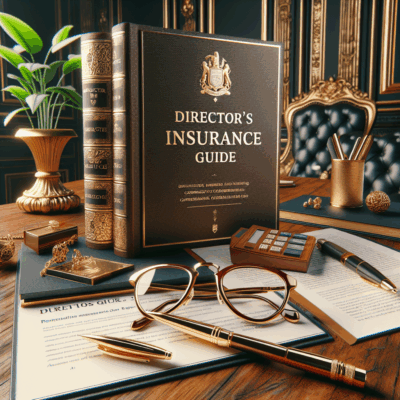Understanding the Imperative of a Directors Insurance Policy
Serving on a board of directors is a position of immense responsibility, influence, and prestige. All company directors are entrusted with guiding an organization’s strategy, ensuring its financial health, and upholding its fiduciary duties to shareholders, employees, and other stakeholders. However, this leadership role is not without significant personal risk. In today’s litigious business environment, directors can be—and increasingly are—sued for alleged wrongful acts, missteps in governance, or decisions that lead to financial losses.
This is where a Directors and Officers (D&O) Insurance Policy becomes not just a prudent safeguard but a critical component of sound corporate governance. It is a specialized form of liability insurance designed to protect the personal assets of a company’s directors, officers, and sometimes, its employees, from the costs associated with legal actions brought against them in their capacity as leaders of the organization.
The Anatomy of a Directors Insurance Policy
A standard D&O insurance policy is typically structured in three parts, often referred to as “Sides” or “Insuring Agreements.” Understanding this structure is key to comprehending the scope of protection.
Side A: Direct Indemnification for Individuals
This component provides direct coverage to the individual directors and officers when the company itself is legally or financially unable to indemnify them. This is the most crucial layer of protection for the individual. Scenarios triggering Side A coverage include:
- Corporate Insolvency: If the company declares bankruptcy, its assets are frozen, making it impossible to indemnify its leaders.
- Legal Prohibition: Some jurisdictions or corporate bylaws may legally prevent a company from indemnifying its directors for certain types of claims, such as settlements in shareholder derivative suits.
- Corporate Decision: The company may simply refuse to indemnify a director, perhaps due to internal politics or a disagreement over the alleged wrongful act.
Side A coverage protects the personal assets—homes, savings, investments—of the individuals from being seized to satisfy a judgment or legal settlement.
Side B: Corporate Reimbursement
This is the most commonly invoked part of a D&O policy. When the company does indemnify its directors and officers for a loss (as it is typically obligated to do by its bylaws or state law), Side B reimburses the corporation for those expenses. This includes defense costs, settlements, and judgments. Essentially, it makes the company whole after it has fulfilled its obligation to protect its leaders, thereby safeguarding corporate assets.
Side C: Entity Securities Coverage
Also known as “entity coverage,” this side extends protection to the organization itself when it is named as a co-defendant in a securities lawsuit. This is particularly relevant for publicly traded companies facing claims from shareholders alleging misrepresentation, omission, or error in financial disclosures that affected the company’s stock price. For private companies, this coverage can often be tailored or omitted based on their specific risk profile.
Why is a D&O Policy Non-Negotiable? Key Risk Exposures
The need for D&O insurance is driven by a vast and expanding landscape of threats. Potential plaintiffs include shareholders, employees, customers, competitors, regulators, and creditors.
- Shareholder Litigation: This is the most classic D&O exposure. Shareholders may allege breaches of fiduciary duty, such as failing to act in the company’s best interest, poor corporate governance, misuse of funds, or lack of oversight leading to a decline in share va
The Critical Role of an Impartial Advisor and the Need to Compare Insurance (we do this daily)
- Employment Practices Liabilities: Claims from employees are a leading cause of D&O claims. These can include allegations of wrongful termination, discrimination, harassment, retaliation, or failure to promote. While some of these may be covered under a separate Employment Practices Liability Insurance (EPLI) policy, they often overlap with and can be brought under a D&O policy.
- Regulatory and Government Investigations: Directors can face personal scrutiny from regulatory bodies like the Securities and Exchange Commission (SEC), Environmental Protection Agency (EPA), or Department of Justice (DOJ). The costs of defending against an investigation, even if it doesn’t lead to charges, can be astronomical.
- Cyber Liability and Data Breaches: In the event of a significant data breach, shareholders may sue directors for alleged failure to implement adequate cybersecurity measures, constituting a breach of their duty of care.
- Mergers & Acquisitions (M&A): These transactions are fraught with risk. Shareholders might challenge the fairness of a deal, alleging the board failed to maximize shareholder value or engaged in self-dealing.
- Stakeholder Activism: Creditors, customers, or community groups may bring suit against directors for actions they believe have harmed their interests.
Without insurance, the sheer cost of mounting a legal defense—often running into millions of dollars—can be financially devastating for an individual, regardless of the merit of the claim.
The Critical Role of an Impartial Advisor and the Need to Compare Insurance
Selecting the right D&O policy is a complex process fraught with nuance. Policy wordings, exclusions, limits, and retentions (deductibles) can vary dramatically between insurers. This is where securing advice from an impartial insurance broker or risk consultant is invaluable.
An impartial advisor operates without a vested interest in selling you a specific policy from a specific carrier. Their duty is to you, the client. Their role is to:
- Conduct a Thorough Risk Assessment: They will work to understand your company’s unique industry, size, financials, operational footprint, and governance structure to accurately identify your exposures.
- Navigate a Complex Market: They have access to a wide range of insurance carriers and products and understand the strengths and weaknesses of each.
- Decipher Policy Language: They can translate complex insurance jargon into plain English, highlighting critical differences in coverage that a layperson would easily miss.
- Advocate on Your Behalf: In the event of a claim, your broker becomes your essential advocate, working with the insurer to ensure a fair and prompt resolution.
A crucial part of this advisory process is the imperative to compare insurance offerings. You should never accept the first quote you receive. A rigorous comparison should evaluate:
- Coverage Terms: Does Policy A have a broader definition of “Wrongful Act” than Policy B? Are there glaring exclusions?
- Financial Strength of the Insurer: The policy is only as good as the company backing it. You need an insurer with the financial stability to pay out claims, especially large ones that may arise years after the policy period.
- Claims Handling Reputation: How efficient, fair, and supportive is the insurer known to be during the claims process? Your broker’s experience here is key.
- Price vs. Value: The cheapest policy is almost never the best.
proposals based on the value of the coverage provided, not just the premium cost.
- Retentions: The amount you must pay out-of-pocket before the insurance kicks in can significantly impact your financial planning.
An impartial broker will facilitate this apples-to-apples comparison, providing you with a clear analysis that empowers you to make an informed decision.
Key Considerations When Purchasing a D&O Policy
Beyond comparing insurers, directors and those procuring the policy should pay close attention to several specific elements:
- Policy Limits: Determine an appropriate amount of coverage. This is a function of your company’s size, risk profile, and the potential magnitude of a lawsuit. It’s common for limits to be in the millions.
- Retention (Deductible): This is the amount the insured must pay before the policy responds. Higher retentions generally lower the premium but increase your out-of-pocket costs in a claim.
- Exclusions: All policies have them. Common exclusions include fraud, illegal personal profit, bodily injury/property damage (covered by General Liability), and pending or prior litigation. Understand them completely.
- Defense Costs: Crucially, most D&O policies provide coverage for legal defense costs, which can be enormous, and these costs are typically outside the policy limit in modern policies (meaning they don’t erode the total amount available for a settlement).
- Side A Difference-in-Conditions (DIC) Policy: For organizations with high risk, a separate Side A DIC policy can be purchased to provide excess coverage specifically for non-indemnifiable losses, often with fewer exclusions.
The Broader Impact: Beyond Individual Protection
While the primary function of a D&O policy is to protect individuals, its benefits ripple throughout the organization.
- Attracting and Retaining Top Talent: Qualified individuals are often reluctant to join a board without the assurance of robust D&O coverage. It is a standard requirement for seasoned directors.
- Enhancing Corporate Governance: The underwriting process for D&O insurance involves a rigorous review of the company’s governance practices. This external scrutiny can help identify and rectify weaknesses, leading to stronger, more resilient operations.
- Ensuring Stability: By protecting both personal and corporate assets from catastrophic legal losses, D&O insurance helps ensure the organization’s financial stability and its ability to continue operations through a crisis.
- Promoting Bold Decision-Making: With the safety net of insurance in place, directors can feel more secure in making the bold, strategic decisions necessary for growth and innovation, rather than being driven by an overwhelming fear of personal liability.
Our Conclusion
A Directors and Officers insurance policy is far more than a simple line item on a corporate budget. It is a fundamental pillar of modern corporate governance and risk management. It protects the individuals who shoulder the immense responsibility of leadership, thereby enabling them to guide their organizations with confidence and foresight. In a world of ever-evolving risks, from cyber threats to heightened regulatory scrutiny, assuming that your company is too small or your industry too safe is a dangerous gamble.
The process of securing this vital coverage demands diligence. Engaging an impartial expert to thoroughly compare insurance products is not an optional step; it is a necessary strategy to ensure that the protection you purchase is as robust and comprehensive as the risks you face. Ultimately,
a well-structured D&O policy is an investment in the organization’s leadership, its future, and its stability. It is the essential safeguard that allows directors to direct.
Frequently Asked Questions
Q: What is a directors insurance policy?
A: A directors insurance policy, also known as D&O insurance, is a type of liability coverage that protects the personal assets of a company’s directors and officers if they are personally sued for alleged wrongful acts while managing the organization.
Q: What does directors insurance typically cover?
A: It typically covers legal fees, settlements, and financial losses resulting from claims of mismanagement, breaches of fiduciary duty, negligence, errors in judgment, and employment practice issues.
Q: Who needs a directors insurance policy?
A: Any company with a board of directors or officers, including non-profits, private companies, and public corporations, should consider this insurance to attract and retain qualified leadership by protecting them from personal financial risk.
Q: Are there any common exclusions in a D&O policy?
A: Yes, standard exclusions often include claims involving fraud, illegal personal profit, bodily injury or property damage, and deliberate dishonest or criminal acts. Policies will also not cover known prior acts or pending litigation.





